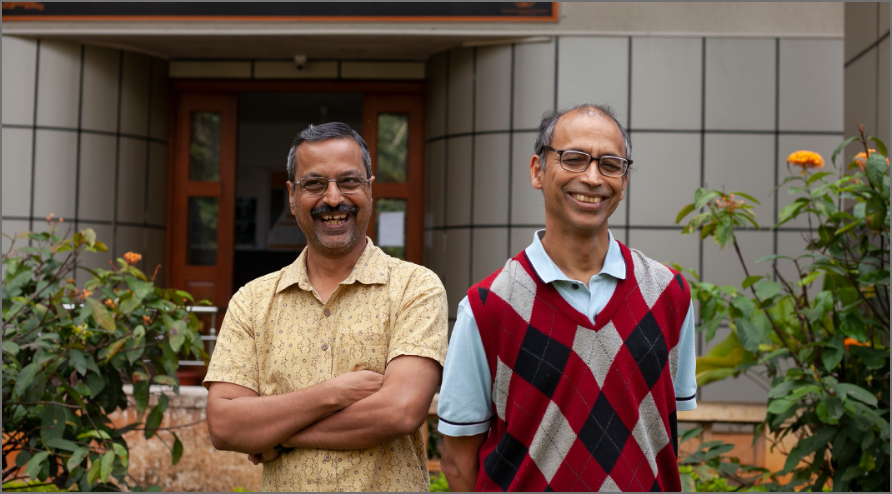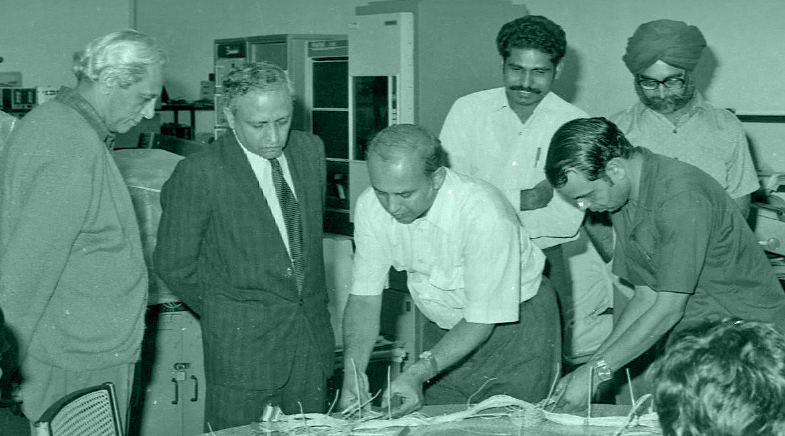The future of growth
-
- from Shaastra :: vol 03 issue 11 :: Dec 2024 - Jan 2025

It's not natural laws, but man-made institutional constraints, that will likely impose limits to growth.
We are living in an age of explosion of technological possibilities. Each generation is able to access technologies that the previous generation could only dream of. Gadgets that we take for granted today, such as smartphones, would have seemed impossible a few decades ago. Cutting-edge medical breakthroughs such as ocular and aural gene therapies, which were treated as holy grail just a few years ago, are moving from laboratory to clinical practice. Brain-computer interface, which once seemed like science fiction, is becoming real (Plugged into the future of brain-computer interface).
Additionally, technological progress shows clear temporal patterns. For example, the cost of sequencing DNA and producing computer chips kept decreasing exponentially over time, as anticipated. Scaling laws in Large Language Models (bit.ly/scaling-llm), too, conform to this pattern.
The question remains whether we can extrapolate this trend. Is there something intrinsic to our socio-economic organisation that allows technological progress to continue unabated? Or will such advances plateau at some point in the future? Worse, will some catastrophic event halt economic progress as we know it?
THE LIMITS TO GROWTH
Broadly speaking, two divergent answers have emerged. First, there are proponents of technological singularity – the view that the rate of technological progress will always accelerate, leading to unlimited energy, intelligence and material production. Mathematician John von Neumann reportedly used this term in a conversation with his colleague Stanislaw Ulam. As Ulam wrote in Neumann's obituary: "One conversation centered on the ever accelerating progress of technology and changes in the mode of human life, which gives the appearance of approaching some essential singularity in the history of the race..."
On the other hand, there are others who hold a pessimistic view of the future. They argue that in a world of finite resources, "accelerating progress of technology" and "limitless growth" are impossible. In this view, economic growth does not happen in a vacuum. It happens within an ecological context. Nature provides source and sink functions for economic activities, and both these functions constrain the scope of economic growth.
The question is: can we extrapolate this trend of supernormal growth? Can technological progress continue without limit?
Starting with Adam Smith, the father of modern economics, economists have been thinking about such issues for long. In fact, The Wealth of Nations, arguably the first book on modern economics, opens with a discussion of economic growth.
The first story about economic growth went something like this. Economic production requires some inputs. Some inputs – for example, muscle power – get wasted if not used immediately. But some inputs can be accumulated or stored – for example, tools and machinery. Such inputs are called 'capital'. If the entire production is used up for immediate consumption, there will be no growth. But if part of the production is diverted for 'capital accumulation', future production capacity will increase, creating further surplus for accumulation, and a virtuous cycle will ensue. In other words, in this story, capital accumulation is the real engine of economic growth. Capital-accumulation-driven growth strategies were common during the first half of the 20th century, including in India.
CAPITAL AND PRODUCTIVITY
However, three types of problems may potentially emerge. First, as we start accumulating economic inputs, the productivity of the accumulated input diminishes over time. Say we have a machine, and we add another machine to our production line. Now the productivity of the second unit will be lower compared to the first one. This observation remains valid for the entire economy as well. As we keep adding to the stock of capital, the productivity of the additional unit diminishes, stalling the growth process.
Romer identified the accumulation of ‘non-rival goods’ – whose consumption by one person does not diminish the availability for others – as the engine of economic growth.
Second, non-renewable resources, being finite, start depleting. An influential study, The Limits to Growth (bit.ly/growth-limits), published in 1972 by the Club of Rome, an influential think tank, raised the possibility of non-renewable resources getting exhausted. Based on a model simulation, the study predicted sharp spikes in the prices of certain primary commodities by the year 2000. However, most of these predictions failed to materialise.
Third, the ability of the environment to absorb wastages and other byproducts of production is called its sink function. Over time, the sink function of nature starts to saturate. Saturation of the sink function is the final critical binding constraint on the growth process. In Delhi and other parts of northern India, for example, we see a regular recurrence of smog in winter. Globally, the emission of greenhouse gases has led to climate change.
OBJECTS VS IDEAS
Nobel Prize-winning economist Paul Romer, known as the 'Post-Scarcity Prophet', postulated the 'New Growth Theory', which provided a coherent explanation of the long-run growth pattern, while factoring in the objections mentioned above. According to Romer, the key distinction is not between capital and labour, but between what he calls objects and ideas. Objects are material things, including machines and tools. Ideas can be distinguished from ordinary goods in being non-rival. If I eat an apple, it will not be available to others to eat. But if I use a particular recipe to make a dish, the recipe can be used by others. In economics, formulas, blueprints, recipes, and even software, whose consumption by one person does not diminish the availability for others, are called non-rival goods. Romer identified the accumulation of non-rival goods as the engine of economic growth.

To use an analogy, economic growth is not about having more ingredients and more cooking: it is about inventing better and better recipes. Romer wrote: "If economic growth could be achieved only by doing more and more of the same kind of cooking, we would eventually run out of raw materials and suffer from unacceptable levels of pollution and nuisance. Human history teaches us, however, that economic growth springs from better recipes, not just from more cooking."
This particular characteristic of being non-rival at the micro level necessarily leads to what is known as increasing returns to scale at the macro level. Increasing returns to scale is a fundamental property of the production process that allows the production to increase in greater proportion than the inputs. For example, under increasing returns to scale, whenever all the inputs are scaled by, say, 10%, the output increases by more than 10%. Without increasing returns to scale, economic growth will not be sustainable.
In short, Romer narrated a logical, consistent story about the growth process: accumulation of ideas leads to increasing returns to scale, which, in turn, drives economic growth. Remarkably, growth can be sustained for a long period of time even in a world of finite resources. "Every generation," wrote Romer, "has perceived the limits to growth that finite resources and undesirable side effects would pose if no new recipes or ideas were discovered. And every generation has underestimated the potential for finding new recipes and ideas."
So far, Romer's story seems to endorse the singularity utopia. New Growth Theory, however, uncovered another problem.
THE HAND THAT MAKES THE MARKET
Ever since the days of Adam Smith, there has been a belief in the 'invisible hand' of the market system. The 'invisible hand' refers to the idea that, even in the absence of a central authority, the free market will be able to coordinate productive activities quite efficiently. As economist Kenneth Arrow once said: "There are undesirable consequences of a free market system, but sheer unworkability is not one of them."

When we need ordinary goods, say bread or butter, we go to the nearest grocery shop and buy the needed commodities. This seems so commonplace that we barely reflect on how much effort has gone into making the goods available to us. Problems are noticed only when this system breaks down – for example, when there is a fertiliser shortage in some parts of the country. But such problems are temporary; usually the price system is able to provide sufficient incentives for sellers to supply goods in demand.
It turns out that the increasing returns to scale – which plays such an important role in unbounded economic growth – is logically inconsistent with the theoretical models of economic organisation where the invisible hand works efficiently! This is a very remarkable and deep result. It requires a bit of mathematical manipulation in order to arrive at this conclusion. But it says that the economics of innovation is drastically different from that of ordinary commodities.
Typically, innovation may happen in one of three ways.
First, innovation may be merely a byproduct of some other useful economic activity – a bit like James Watt discovering the power of steam while boiling water to make tea. There is no conscious, planned effort at innovation. Innovation is just manna from heaven, a result of serendipity. If a process is serendipitous, driven largely by chance, the speed of technological innovation will be slow.
Second, research and development may be publicly funded. The National Science Foundation in the U.S., for example, is one such funding agency. But government support is not without costs. The government is able to provide financial support only by taxing some economically useful activity, creating what economists call a 'deadweight loss of taxation'.
Third, research and development can be financed by monopoly profit. Some firms may have a dominant position in certain markets. They may be able to overcharge for some of their products, earn monopoly profit, and deploy it to finance new innovations. However, overcharging necessarily means that some consumers are prevented from purchasing the goods they otherwise would have.
It is no coincidence that AT&T Bell – an extremely innovative company responsible for the development of transistors, lasers, communication satellites and operating systems – was a regulated monopoly. Even today, a big corporation such as Google has deployed part of its earnings to develop AlphaFold, whose developers won the 2024 Nobel Prize in Chemistry.
WHERE INNOVATION THRIVES
In other words, there is a tension between rewarding innovation for sustainable growth and making the economic system work efficiently. Some trade-offs need to be made. There are no perfect solutions. Economist Avinash Dixit put it succinctly: "The world is second-best at best."
Some other insights follow as well. Innovations can happen only under certain institutional arrangements. And the institutional infrastructure underlying innovation is more fragile than we imagine. Antitrust action against AT&T Bell, for example, led to the end of its great innovation ecosystem. Similarly, when innovation is publicly funded, it is usually subject to the vagaries of electoral outcomes.
Even if technological development continues at the global level, there will be plenty of local variation in the diffusion of ideas.
Moreover, such institutional arrangements differ across time and space, implying an uneven temporal and spatial distribution of innovation. Historically speaking, most of the technologies we are accustomed to were invented in the past two centuries. Economic growth and technological development have a spatial pattern as well. Technological development is usually clustered in certain geographic locations – for example, in Silicon Valley in the U.S. What it implies is that even if technological development continues at the global level, there will be plenty of local variation in the diffusion of ideas.
Economic research has provided a more nuanced view of the possibility of growth. In a way, it has replaced 'resource pessimism' with 'institutional pessimism'. Unbounded growth is possible, but not inevitable. At the risk of simplification, the 'limits to growth' do not come from natural laws, but from man-made institutional constraints.
As Shakespeare famously said: "The fault, dear Brutus, is not in our stars, but in ourselves..."
Have a
story idea?
Tell us.
Do you have a recent research paper or an idea for a science/technology-themed article that you'd like to tell us about?
GET IN TOUCH















